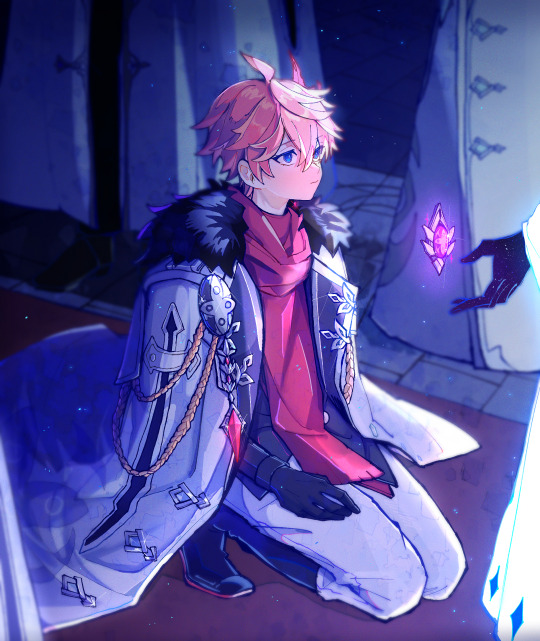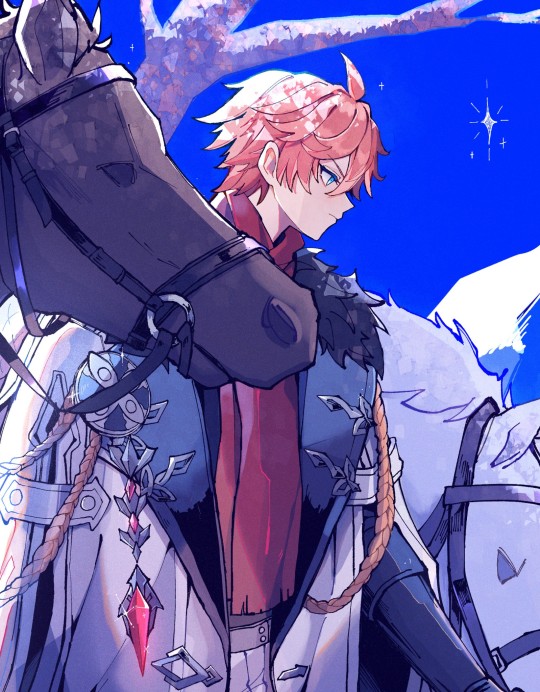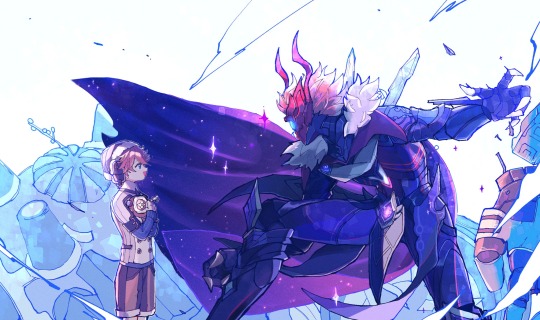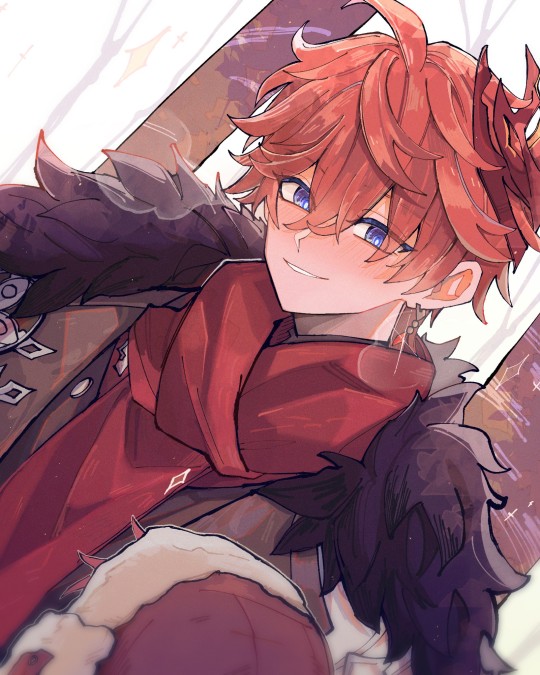Analysis of anime and entertainment • Hobbyist illustrator and Graphic Designer • Currently into Genshin Impact ✨ lvl60 ✨ Tartaglia simp • This profile has been severely infected by chilumiware ✨🐋. Caution is advised!
Don't wanna be here? Send us removal request.
Text
Kabbalah in the Worldbuilding of Genshin Impact; Part 2: Descending to the Garden
Written by Sabre (@paimoff on twitter) and Schwan (@abyssalschwan on twitter)
This theory assumes you’ve completed the Fontaine Archon Quests, as well the Narzissenkreuz questlines. If you haven’t, you will be a) very confused and b) very spoiled.
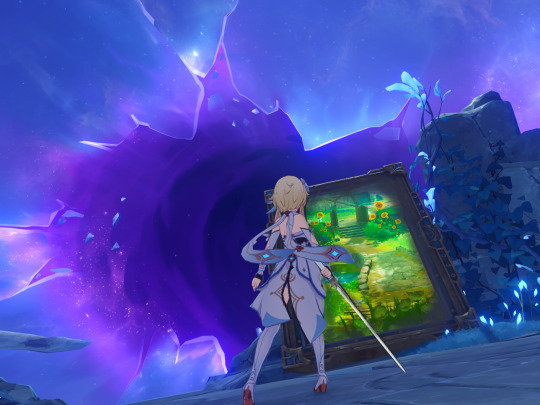
A Tale of Four Descenders
Four entered the pardes (orchard/garden)...one looked and died, one looked and went mad, one looked and cut down the saplings (apostatized), and one came in peace and left in peace [1].
This Jewish legend appears in multiple locations throughout the Talmud and its commentaries, and is associated with two pre-Kabbalah schools of Jewish mysticism known as Merkabah (chariot) and Hekhalot (palaces) mysticism. Both depicted visions of the throne of God (chariot) and the heavenly palaces, and provided instructions for how one might ascend to heaven to receive some kind of revelation or knowledge. The orchard/garden represents esoteric Torah (Jewish law) knowledge; this is why the euphemism for apostatizing is to “cut down the saplings.” (I know he says “blasphemy” (which is different), but this is reminiscent of what Dottore says at the end of Winter Night's Lazzo.)
The pardes legend first appears as a warning to scholars about the consequences of teaching about the “chariot” to disciples who are not ready. Though it's not mentioned in this specific text, this process of meditating to ascend to the palaces of God is referred to as “descending” in the writings of the Merkabah mystics [2]. In other words, this legend tells the story of four descenders.
In the conclusion of the Sumeru Archon Quests, Nahida tells the Traveler about the existence of the “Descenders." Based on the information she got from Dottore in exchange for her Gnosis, she shares that:
Descenders are “external beings, ones that don’t belong to this world”
There are at least four of them, and the Traveler is the fourth
According to the Fatui, the Traveler's twin is not a Descender
The Traveler is not recorded in Irminsul, but their twin is
Nahida speculates that the First Descender is the Heavenly Principles, but the identity of the second and third are unknown to her. At that point though, we still didn’t know what it was that Descenders do, or what the exact criteria for being one is, only that it couldn’t be as simple as just being from outside Teyvat.
The Fontaine World Quest series about the Narzissenkreuz Ordo fills in some pieces of the puzzle; specifically an additional criterion to be a Descender: they must be someone with a will “that can rival an entire world.”
In retrospect, Inversion of Genesis also hinted at the role of a Descender; The Traveler witnesses the results of someone attempting to change fate and/or the world and failing.
Nahida: Changing the world, changing the past, changing the fates of other people... These are not simple things to accomplish. Nahida: What you were looking for is complete annihilation... But this is just a fantasy. Even if The Balladeer is removed from existence, the world will not heed your will. (Inversion of Genesis)
For most people, actually “changing the world” is impossible. But for a Descender, it might be different.
Will
...Though the results are nothing impressive, this is because the object they chose was pure elemental force, which lacks any will whatsoever. Like the difference between the Director (Lyris) and a Hydro Slime, perhaps? ...Actually thought of a possible breakthrough during the process... Even though the calculated result is unchanged, but if the refinement method is reflected... If the power of... then maybe we can extract the "will" within. Using this method... resist the impact… (Excerpts from Rene's Investigation Notes)
...The true source of the mysterious power unique to this place that the locals call Khvarena is unknown. But based on its ability to eliminate or reverse the influence of the Abyss (in fact, it is a type of annihilation reaction), the two powers are of the same level, that is to say, they are of the same order in terms of rules... ...In other words, both possess the power to "re-write the rules"... ...Regrettably, be it Abyss or Khvarena, all current users are stuck in an "unconscious" stage of being influenced and overwritten by their power… (Bizarre Transcript)
The Gavireh Lajavard region of the Sumeru desert introduced us to the writings of Rene, a precocious researcher with world-saving ambitions and not nearly enough adult supervision, as well as his only slightly Abyss-corrupted bestie Jakob. Like the Khaenri'ahns before him, Rene was searching for a power that had a “will,” believing it necessary to save Fontaine from an unspecified disaster that we would later learn is The ProphecyTM. During their time in the desert (which was right after the cataclysm), Rene determined that both Abyssal and Khvarena power have a will, but pure elemental energy did not.
Some time after their trip to Sumeru, Rene and Jakob would found the Narzissenkreuz Ordo, with the goal of finding a way to save Fontainians from being dissolved in the primordial sea-laced floodwaters. They would do this by dissolving all humans in Fontaine with primordial seawater in a controlled manner, melding everyone together into one Oceanid-like being to survive the apocalypse (think Human Instrumentality Project from Evangelion). Rene had predicted the coming apocalypse with something he called his “world-formula,” and in addition to predicting the doom of Fontaine, it also informed him that “unlike the world depicted in these ancient texts, there will be no more new civilizations born.” The only way this could be changed would be by introducing a new “‘variable’ from outside the system” into the formula (Enigmatic Page 1). Rene’s goal was to become this variable, i.e., a Descender.
Four Worlds
The Tower of Ipsissimus comes from an old concept from the ancient Fontainian kingdom of Remuria, and was used to describe a powerful will that could rule, sustain, and destroy the world. This tower was designed by the Narzissenkreuz Ordo, and it represents the evolution of the human soul and the infinite mysteries of the world. The Narzissenkreuz Ordo believes that people continuously refine themselves through samsara cycles. These include Hyperborea, Natlantean, Remuria, and the first half of the fourth samsara (Khraun-Arya), which we are presently experiencing. Please take note that these are just names given to these eras by the Ordo based on ancient texts, and this evolution refers to spiritual evolution. There is no intent here to antagonize any research results obtained by the Akademiya. The human spirit undergoes the loss of paradise, the defeat of evil dragons, the original sin and baptism, and finally, freedom from the gods.
The term samsara is typically used to refer to the cyclic nature of reality, and can be used to describe concepts like reincarnation. It is not, however, referring to time loops. There is A Lot to unpack about this note, but for the purposes of this theory we will be focusing on the concept of these “four samsaras” and their relationship with the concept of a Descender, specifically that there seems to be the same number of samsaras as Descenders.
You may be wondering - this is Kabbalah world structure theory and we’ve yet to discuss Kabbalah. Well, it’s time now! But before we can get into specifics, we first need to review some terms discussed in Part 1 and then go through some basics of Lurianic Kabbalah. Ah, the irony of calling anything about Lurianic Kabbalah “basics.” Caveat that what follows will be a simplification of concepts that are very difficult to grasp (I definitely don’t know what’s going on).
Creation of the World, Kabbalah Edition Previously, we compared the “limitless light” emanated by God to create the world to the power of elemental energy, and compared the sefirot of the Tree of Life to the seven elements. The sefirot are components of this divine light (like light passing through a prism and refracting) and represent attributes of God that are used to create the world. The sefirot are traditionally depicted together in the form of a tree, which maps out their relationships with each other. For more details on the similarities between Kabbalah and Genshin worldbuilding, consult Part 1 (link) if you haven't read it yet.
Kabbalah focuses on describing the relationship between the infinite God and the finite universe and how it was created, with variations between different schools of thought. In this theory, we’ll be primarily focusing on the ideas of the Kabbalist Isaac Luria. The central idea of Luria’s philosophy was a concept he called Seder Hishtalshelut, or “Order of Evolution,” which refers to the cycles of “exile” and “redemption” (creation and destruction) the world is eternally experiencing. In the Lurianic system, time isn’t linear; the world was created in the past, but it’s also being created now.
The beginning of this Order of Evolution is referred to as the Tzimtzum, or Contraction. This refers to the contracting of the infinite God to make a space where reality could be created. Once this is created, a ray of divine light enters the void and begins to emanate reality. This is similar to the concept of the Pleroma in Gnosticism. The further the divine light gets from the source, the more it starts to break down into separate parts. More specifically, it breaks down into the Four Worlds, which represent stages of the evolution of reality, but also stages of the spiritual evolution of the human consciousness.
The Four Worlds are: 0. Adam Kadmon - Primordial (Original) Man 1. Atziluth - Emanation 2. Beriah - Creation 3. Yetzirah - Formation 4. Assiah - Action Material reality is distinct from these four worlds; the ‘real’ world emanates out of the fourth world, Assiah. Each of these four worlds have their own sefirot structure, which in themselves contain additional sefirot, on and on, like a fractal. Luria called these recursive structures “tree systems” [3]. In Genshin terms, this is like how we have Irminsul, the world tree, but also the other smaller Irminsul trees in domains.
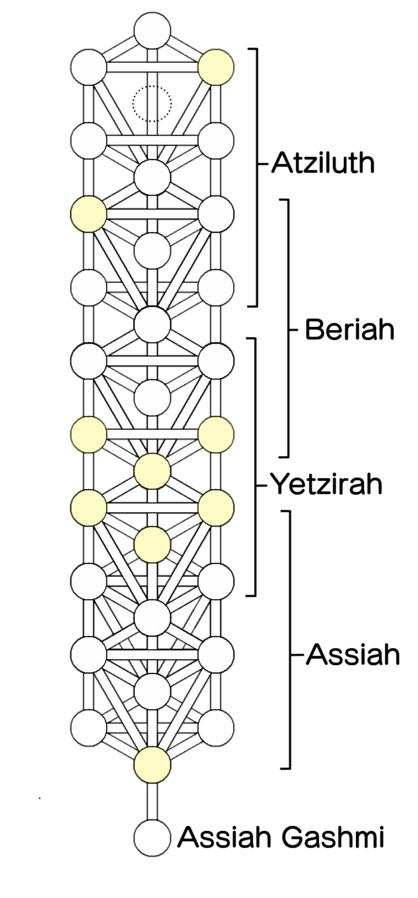
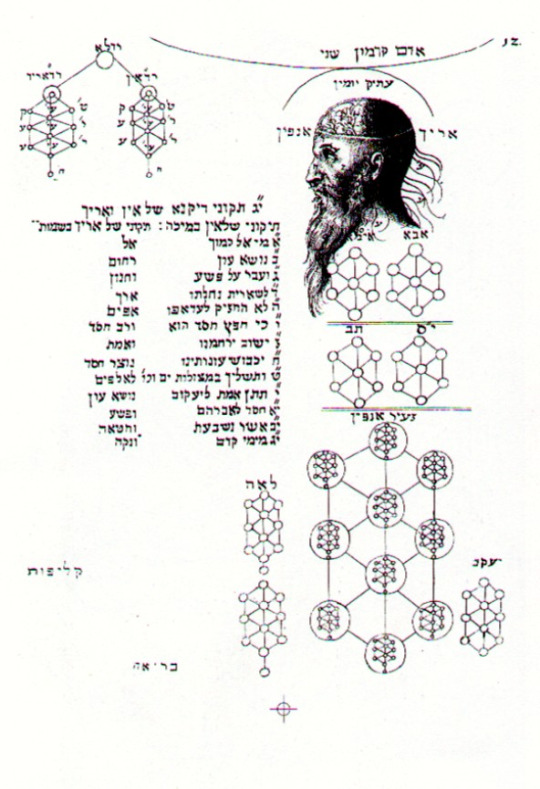
(Fun Fact: this schematic is sometimes called Jacob's ladder) The system of the Four Worlds and their nuances are very interesting in themselves, but for the purpose of this theory, we’ll be focusing on the 0th world, Adam Kadmon, and the symbolism associated with this concept in both Kabbalah and general Jewish philosophy.
Primordial (Hu)Man
The concept of an ‘original man’ is discussed in Philo’s commentary of Genesis, where he describes this being as androgynous, connected to the concept of Logos, and the Idea/Form of humanity in contrast to the ‘earthly man.’ Philo’s definition of the Logos was something closer to the concept of a demiurge-a being responsible for creation of the world. Logos literally means ‘word’ or ‘reason’, and otherwise typically refers to divine reason, or the word of God. It’s important to note that here the use of the word ‘man’ refers to a human being, not specifically a male person. Though often described as a man, the Primordial Man of Kabbalah is considered androgynous (like the Primordial One of Genshin).
The Zohar (a foundational work of Kabbalah) describes the Primordial Man as the “image of everything that is above [in heaven] and below [upon earth]; therefore did the Holy Ancient [God] select it for His own form.” The Primordial Man is the personification of the 10 sefirot together and represents a microcosm of the universe (macrocosm) [4].
Narzissenkreuz: I... I sense "reason." Visitors, are you the successors to Narzissenkreuz, or are you a threat? Narzissenkreuz: Is "Reason" that which grants you such strength? Narzissenkreuz: No, I have noticed. Have you always been in that realm that I pursue? O, you who are equal to a world! (Waking From the Great Dream) Man, as he was before his fall [first sin], is conceived as a cosmic being which contains the whole world in itself (Trends in Jewish Mysticism, pg. 215)
Lurianic Kabbalah considers the Primordial Man to be the highest level manifestation of God that can be conceptualized by humans. The world of Adam Kadmon precedes the emanation of the lower Four Worlds, but each of these worlds have their own corresponding anthropomorphic figure as well [5]. In contrast to the worlds that follow Adam Kadmon, the sefirot of Adam Kadmon are not in a Tree of Life configuration, but rather in the configuration known as “upright,’ arranged in the shape of the human body.
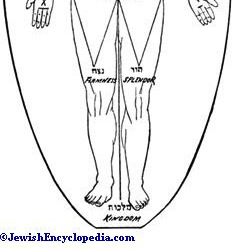
The concept of a Primordial Man exists in other religions and mythologies as well. There’s the Gnostic Anthropos, Adam Kasia of Mandaeism, the ‘Universal Man’ (al-Insān al-Kāmil) of Sufism who functions as an Axis Mundi, the world-soul of Platonism, Gayomart of Zoroastrianism, and more. The symbolism of the human body as mediator between the divine and the material world is not unique to Kabbalah. Kabbalah’s version of the World Tree and Primordial Man both function similarly to the Axis Mundi; they are the same emanations of the divine, just arranged in different configurations.
Will and the Primordial Man In Kabbalah, Adam Kadmon represents the will of God, specifically the will to create. The blueprint for the creation of the world is contained within this being/world, all superimposed together into a “primordial thought.” Within Adam Kadmon, there is no distinction between the individual sefirot, or rather, between anything at all. Everything is contained with this world/thought, but there is no time, no space, and no limitations. WIthout limitations, individual beings and concepts cannot be created. Therefore, the unity of Adam Kadmon had to be broken; specifically into the 10 sefirot, which could then assemble themselves into new configurations and continue the process of creation [6].
Narzissenkreuz: The witness of all, the recorder of all, the designer of all. Narzissenkreuz: Only one who is worth a world can bear that title. (Waking From the Great Dream) If the righteous wish to do so, they can create a world. (Babylonian Talmud, Sanhedrin 65b)
Back in Part 1, we compared pure elemental energy to Kabbalah’s divine light of creation and the ten sefirot to the seven elements. If we apply this analogy to Adam Kadmon, doesn’t a being that could (theoretically) resonate with all elements and would eventually meet their end by being broken up into many pieces sound familiar?
At the end of Act V of the Fontaine Archon Quest, Skirk tells Neuvillette that the Gnoses are actually the “remains of the Third Descender.” Neuvillette, the Traveler, and Paimon speculate that this is possible because as a Descender, they would have also had the same unique compatibility with the elements as the Traveler. Neuvillette’s character stories refer to the remains of the Third Descender as the “seven remembrances,” which were used to create a new “order” for the world, with “all fragments of the primordial…driven to devour each other.”
Rene’s notes in the Tower of Ipsissimus directly tell us that there is a connection between the concept of the Primordial Man and Descenders:
"Lies beneath the great sea" is, itself, an interesting phrase. It comes from ancient Sumeru texts, and should be read as "Narayana*," which also means "primordial human." This, too, is my goal, for not all that comes from beyond may be as one that "descends." That title belongs only to wills that can rival an entire world. That is what I seek, the way to become just such a will, one that can protect the world, sustain the world, destroy the world, and create the world.
[*Narayana (Sanskrit: नारायण, romanized: Nārāyaṇa) is one of the forms and names of Vishnu, depicted as sleeping under the celestial waters, and is associated with creation. This reference aligns with Rene’s goal of using the power of the Primordial Sea to make himself a Descender. ]
In summary, we have four Descenders, we have four samsaras, and we have four symbolic worlds that are only able to exist due to the destruction of a 0th world known as the Primordial Man, who represents the totality of the divine Will to create the world and the Idea of humanity.
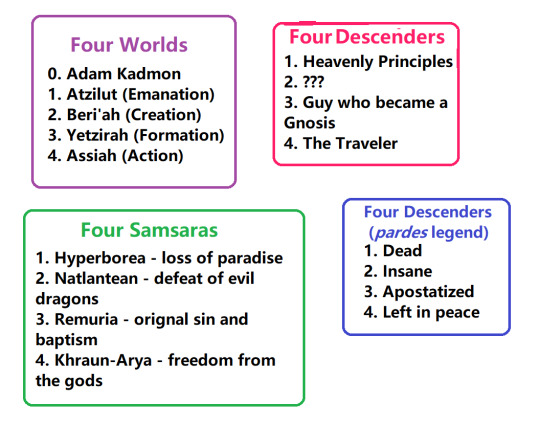
Keep all this information in mind, because before we can discuss the connections between samsaras, Descenders, and the Primordial Man, we must take a detour into alchemy and psychology.
Primordial God Impact
Genshin Impact has always been about the primordial - it’s literally in the name: 原神, or yuan shen, which means ‘original god.’ Many other in-game items share this descriptor, including primogems (原石), Primordial Seawater (原始胎海之水), and the Primordial One (原初的那一位). The same characters are also used in the note from the Tower of Ipsissimus when referring to the ‘primordial human’: 原初之人, which as it turns out, is exactly the same word used for the Primordial Human Project.
The Primordial Human Project has been mentioned exactly once, in a cutscene from the Shadows Amidst Snowstorms event in version 2.3. There, Albedo refered to his doppelganger who had been wreaking havoc on Dragonspine as the “failure of the Primordial Human Project.” Albedo implied that he is the “survivor” of an experiment associated with the Primordial Human Project and considers it to be related to his origins as a creation of Rhinedottir, aka the alchemist Gold.
We know very little about Rhinedottir and her motivations. She’s a practitioner of the Art of Khemia, a member of the Hexenzirkel, is labeled a sinner and blamed for the appearance of monsters during the Cataclysm, made a dragon named Durin and sent him to Teyvat during said Cataclysm, where he caused destruction everywhere he went while thinking he was playing, and might have also made Elynas, who had a similar fate. According to Skirk, she, like Skirk’s master, is “pursuing some form of perfection.”
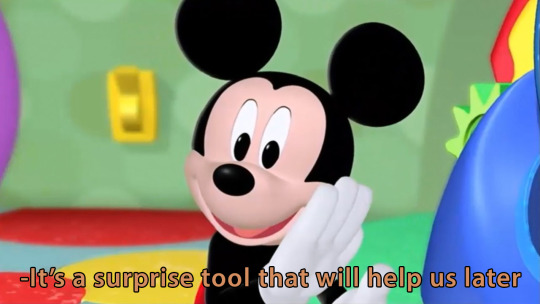
The Great Work
Rhinedottir’s alchemical research was focused on the creation of new life and she was familiar with an alchemical text called the Opus Magnum, which she left behind for Albedo to study. The Opus Magnum is a reference to the real life Magnum Opus, or Great Work, which refers to the alchemical process of creating the philosopher’s stone from the prima materia (original matter). The process typically goes as follows: nigredo (blackness), albedo (whiteness), citrinitas (yellowing) and rubedo (redness). Later Western alchemy would merge the citrinitas and rubedo steps into just rubedo, or include additional steps, such as the peacock’s tail stage between nigredo and albedo. Notably, the order of the last two steps in this process is reversed in the version of the process Albedo learned from Rhinedottir: rubedo is third, with citrinitas last.
This reordering isn’t universal in Teyvat: Rene’s notes disparage this choice, saying that Khaenri’ah is distracted from the true goal of the process:
..."Red" is the foundational principle, the philosopher's stone*, while "yellow" represents gold and mortal temptation. Yellow is simply bait. Red is the final goal. However, Khaenri'ah would likely seek the truth for gold's sake before turning that truth into a bread production pipeline…
[*This is the first and so far, only, time the phrase “philosopher’s stone” has been directly mentioned in-game.]
Rene has a somewhat ironic take on the Khaenri’ahn alchemical philosophy, given that Albedo’s character stories specifically say “Khaenri'ah was an underground realm, with precious few natural fauna. As such, its alchemy focused more heavily on the creation of life.” Rene often has strong opinions - but why would he care about the order of the Magnum Opus?
The Chymical Wedding of Rene de Petrichor
A recurring motif of the Great Work is the ‘chemical wedding.’ This refers to a union of opposites; male and female, sun and moon, fire and water, sulfur (Red King) and mercury (White Queen), etc, and is often depicted as taking place in a fountain. Here, in this drawing from a copy of the Ripley Scroll, sulfur and mercury wed and form the androgynous (like the primordial man) ‘philosophical child,’ which is philosophical mercury.

Philosophical mercury is the underlying principle or “divine flow” that makes alchemy and transmutation possible. Therefore, the goal of the Great Work was to pin down this mercury into matter through the four (or more) stages of the Great Work and make the philosopher’s stone [7,8].

"The Stone that is Mercury, is cast upon the Earth, exalted on Mountains, resides in the Air, and is nourished in the Waters." (Michael Maier's Atalanta Fugiens. 1617.) The cubes represent prima materia. ;)
The chemical wedding is also used as a motif throughout the story of the Narzissenkreuz Ordo. The Book of Revealing includes a schematic of the “Seal of Chymical Marriage,” which consists of a “Tree of Emanation'' and the “Four Orthants,” and was used to seal the Primordial Sea. The Tree of Emanation component is, of course, a version of the Kabbalistic Tree of Life - for more ramblings, feel free to check out my twitter thread here.
The Narzissenkreuz Ordo is likely intended to be a reference to the real life Rosicrucian Order, and the name of the seal a reference to an important text for this order called the “Chymical Wedding of Christian Rosenkreutz.” Other possible references to chemical weddings include Lyris being referred to as the ‘Red Empress,’ Rene using her power to dissolve himself and be reborn through the water, and Mary-Ann and Lyris fusing and eventually producing “pure water” aka Ann. Actually, when you dig into it, there are many suspicious interactions between sun and moon-coded gods in Genshin lore, as well as the doomed wedding of the Seelie and the traveler from afar. My Name For Now made a really interesting video about this, so if you would like more information and speculation, check it out here.
The Philosopher’s Stone and the Self
The philosopher’s stone is the Holy Grail of alchemy: an alchemical substance that can transmute base metals into silver or gold, make someone immortal, cure all illness, make a homunculus, and more. The stone represents perfection and spiritual refinement, either of nature through alchemy, or of the self (the alchemist) [8].
Carl Jung, the founder of analytical psychology, considered the steps of the Magnum Opus to represent the process of the individuation of the self from the collective unconscious. The similarities between his interpretation of alchemical symbolism and the ideals of the Narzissenkreuz Ordo deserve their own separate analysis, but in brief: Jung defined the collective unconscious to be the shared unconscious mind between humans, full of basic instincts and archetypes, which are primordial symbols that exist in many mythologies throughout the world. Jung compared the collective unconscious to the alchemical symbolism of water, which he describes as “wisdom and knowledge, truth and spirit, and its source was in the inner man [9].” The process of individuation separates aspects of the personality from the unconscious (the water) and then eventually integrates all components together, to form the individual self, which can now bring “order” to the unconscious (at least on a personal level)[10]. In other words, the Jungian interpretation of the Magnum Opus is that the final product, the philosopher's stone, is the Self.
If we apply this symbolism to Rene’s journey, it appears he was attempting to refine himself into a philosopher’s stone, which would explain why he was so interested in the work of the Khaenri’ahn alchemists. As he stated multiple times, his goal was to become a “primordial human,” whose will “can rival an entire world.” Rene’s philosopher’s stone is a Descender.
The Primordial Human Project
After Rene’s failed attempt to dissolve himself in Primordial Water and be reborn using Lyris’s power, Jakob turned to his own research to try to save Rene and complete his rebirth. In his log of this time period, Jakob wrote:
...I've been interpreting the data in search of a solution and sharing the results with Rene. There has still been no response, but I can already envision his response with perfect clarity: criticizing the Universitas Magistrorum for putting the cart before the horse, neglecting the fundamental principles underlying everything, and diving straight into the details of how to put those techniques to use... How they inverted even the alchemical stages for other purposes… ...It seems that there was an alchemist from Khaenri'ah named "R" who joined a secret order. From what fragmentary records exist, it appears that they made significant headway.
There are two items of note here; the first is the mention of Universitas Magistrorum, which previously had only been mentioned in a namecard description. The card description reads "O Almighty Sovereign, the Universitas Magistrorum has provided the predictions you requested: The two stars have been captured by the world's gravity…” which may be referencing Khaenri’ah’s summoning of the twins (Inversion of Genesis). From the context of Jakob’s notes, we can infer that this organization was also utilizing some form of the Magnum Opus for an unknown purpose.
The second item of note is the mention of the alchemist “R,” who is almost definitely Rhinedottir, and the “significant headway” that she and this mysterious “secret order” made. It’s very likely that Jakob is interested in Rhinedottir’s work simply because he wants to make a new body for Rene; the log also mentions Remurian golems and experiments with prosthetic limbs. However, the mention of her and the Universitas Magistrorum in the same context, with Jakob’s commentary on the reversed order of the Magnum Opus, gave me the idea that sparked this whole theory (descent into madness): Is it possible that Rhinedottir’s Primordial Human Project was intended to make a Descender?
Sometimes, very important lore gets buried in character stories. For example, the first time the term “primordial (hu)man” shows up - which is in Albedo’s fifth character story.
This art of creation was known as "The Art of Khemia." Albedo had learned of this in his youth from reading his master's notes. The next stage after "soil" is "chalk," which was also something his master had mentioned. "Chalk is the spotless soil, and was used to make primordial man." Now, Albedo understands alchemy in far greater depth than he did in the beginning, and his knowledge on the subject is far more comprehensive. "From soil was birthed chalk." The profundity of this statement is well understood by Albedo now.
Albedo is also the “chalk”; Rhinedottir gave him the title of Kreideprinz, or Chalk Prince. She seems to have a habit of naming her creations after types of soil. Durin was ‘humus,’ the Riftwolves are ‘alfisol,’ and Albedo is ‘cretaceus’. According to her, earth is “the basis of all life” and the “accumulated memories of time and lives,” so it makes sense she’d use soil as the starting material for her alchemical creations.
Albedo seems to be aware of the Traveler’s unique status, although he never names them as a Descender. During his Story Quest, Albedo studies the Traveler to get insight on how to help an alien flower bloom.
Albedo: The only other life form that, like you, has come here from afar, is the seed that I mentioned. Under the effects of Teyvat's natural laws, it isn't even able to sprout, let alone bloom. Albedo: But after I observed you, I had another idea. Albedo: Imitating you helped to inspire my alchemy, and so... Albedo: Is not nurturing otherworldly life also nurturing the world itself?
Following the experiments he performs on them, he reveals to the player that he lied about some of their test results, and even compares himself to the Traveler.
Albedo: I made a point throughout of telling them how ordinary the results were... Albedo: But what was that sediment I saw forming at the bottom of the vial? It should not have been there... What could it mean? Albedo: Those born of earth are bound by its imperfections, but those born of chalk are free of impurities... You and I are alike, both composed of a substance that has yet to be fully defined...
This leaves us with questions. Assuming Albedo is similar to the ‘primordial human’, what is his role? Is he a Descender, or is he meant to work to become one eventually, like Rene tried to do?
Let’s return for a moment to the Primordial Man and Adam Kadmon. Earlier, we discussed the symbolism of Adam Kadmon; this being represents the divine will to create, also known as the “primordial thought,” as well as the Idea of humanity. Adam Kadmon is the potential for creation unified together, with no distinctions between any concepts. Hermeticism and alchemy have a similar concept, succinctly summed up in the phrase “the all is one,” which can be found written on one of the earlier alchemical drawings of an ouroboros by Cleopatra the Alchemist [11].

In Gnosticism and alchemy, this symbol refers to unity of all material and spiritual things, as well the eternal cycle of destruction and re-creation as things change form [12].
Rhinedottir shared this philosophy, as evidenced by the description for Cinnabar Spindle, Albedo’s sword.
Separate the dust in the flames with joy, and extract the exquisite from the crude. For all in the universe comes from a single source, and all things may be derived from a single thought.
The weapon description also contains instructions for Albedo that likely tie into his expected role as a success of the Primordial Human Project.
You must pursue that which your elder brother, the one-horned white horse, could not accomplish. Reach the far side of philosophy, and create a new destiny for myself and your brothers…
Albedo’s final assignment from Rhinedottir is to learn the “truth and the meaning of this world,” a phrase echoed by the Abyss Twin in We Will Be Reunited. Knowledge is literally power in Teyvat: both Nibelung the Dragon King and later, Deshret, utilized Forbidden Knowledge, also referred to as a “power of darkness from outside of this world”, believing it to be the only effective power to defeat the Heavenly Principles. In fact, it’s even possible that the Dragon King was one of the Descenders despite presumably being native to Teyvat. The process of acquiring the Forbidden Knowledge could have evolved him to true Descender status, although this power appears to be incompatible with Teyvat, especially in the wrong hands. The power of the Forbidden Knowledge is similar to the metaphorical garden of the pardes myth, where out of four “descenders,” only one was able to safely leave, with the esoteric knowledge gained. The philosopher's stone also represents knowledge-it is the lapis philosophorum; literally the 'stone of wisdom'. Knowledge is also how one ascends in Gnosticism, i.e, achieving gnosis.
Perhaps this is the true method to create a Descender and Albedo’s future role: once he reaches the far side of philosophy (learns the truth and meaning of the world) and ‘evolves’ and ‘refines’ himself from albedo through rubedo and citrinitas to the philosopher’s stone, he can change destiny.
This sounds familiar…
Fortuna and Evolution
Rene’s calculations of the world-formula predicted that following the fulfillment of Fontaine’s prophecy, there would be no new civilizations formed from the ruins, as there presumably had been in the past following similar disasters. Rene believed the only way around this was for him to become a Descender, and save Fontaine from the disaster, beginning a new age. It’s implied in the text of the Book of Revealing (the version in the WQ) that the fulfillment of the prophecy would spell disaster for all of Teyvat, not just Fontaine, but even if that were not the intent of Celestia, we can use this example as an analogy for the world-formula of Teyvat.
Rene directly compared the world-formula to the Remurian concept of Fortuna:
Kingdoms rise and fall, and when a civilization is annihilated, a new one will be born after from the ashes, which these books refer to as "Fortuna"... It's somewhat rudimentary, but theoretically at least, it bears striking resemblance to the computational scheme I have formulated and termed "world-formula"...
Let’s spin the wheel of Fortuna and return to the beginning, where we first discussed the four samsara cycles of spiritual evolution and the Four Worlds. Although the samsara cycles don’t refer directly to actual historical events, their names are based on ancient texts. It’s not a large leap in logic to suggest that each of the four samsaras refers to eras in Teyvat’s history- what others in the lore community have been referring to as ‘root-cycles.’ For example, the defeat of evil dragons associated with the Natlantean samsara could refer to the war between the Primordial One and the vishaps described in Before Sun and Moon, or the war between the Heavenly Principles and the Dragon King (which might be the same thing!). The events associated with each samsara must be what ends the samsara, since the fourth, Khraun-Arya, is the current, and represents freedom from the gods, which has not happened yet.
Given that the Descenders can (theoretically) change the result of the world-formula/Fortuna, it can’t be a coincidence that there are the same number of Descenders as there are known samsaras. In addition, if the four samsaras of Teyvat function like the Four Worlds of Kabbalah, that means that a samsara-ending event would be something that results in the evolution of the world. Apep says that during the war between the Dragon King and the Heavenly Principles, Teyvat was in danger of collapsing, and that the victor of the war would “inherit the right to shape the world”. This sounds a lot like Rene’s definition of a Descender: one that can protect the world, sustain the world, destroy the world, and create the world. The death and disassembly of the Third Descender led to a significant change in the “order” of Teyvat when the Gnoses were created to replace the “ruined” functions of the Heavenly Principles. Put another way, Descenders are able to evolve Teyvat into its next stage of evolution.

The fate of the Third Descender and ruined functions of the Heavenly Principles suggest another, alarming component to the relationship between samsaras and Descenders. It could be that as part of the process, a Descender must replace or repair an aspect of the mechanisms that maintain Teyvat. Don’t worry about the Traveler though; the fourth descender of the pardes legend gets to leave the garden in peace.
On the other hand, the first Descender in the legend is the one who dies, and in Genshin it’s the third, so maybe the list isn’t exactly in order. Of course, this comparison to the legend is partly a joke, but it is very interesting that the metaphor for apostatizing is uprooting trees….
Khaenri’ah’s World-Formula
We know from Rene’s notes that Khaenri’ah had their own version of a world-formula, or at least, their records contained information Rene could use to reverse engineer their predictions. We don’t actually know what he found there, but based on the name he gave the fourth samsara and the whole “freedom from the gods” thing, it seems they were trying to evolve Teyvat into the next samsara and make this freedom a reality. We also know that the Khaenri’ahns were searching for a specific kind of power, a power they referred to as both a “perpetual” energy source and a “secret from beyond the skies” that could “throw off the shackles imposed by this world's laws.” This power from “beyond the skies” is thought to be some form of Abyssal power, and the Khaenri’ahns who used it seem aware of a will contained in that power, a “dogma from beyond the heavens.” In fact, it’s possible that this power is the same as the Forbidden Knowledge brought in by Nibelung, which also had an influence on Apep’s behavior when they were infected with it after eating Deshret.
It appears that Khaenri’ah was familiar with something similar to the concept of a Descender, which makes Chlothar’s words to the Traveler in Caribert all the more impactful.
Chlothar: I never imagined that you, of all people, would deny the Abyss... How ridiculous! Chlothar: We once believed that you would bring new strength and hope to Khaenri'ah. Chlothar: To us, you were the Abyss... A wondrous mystery far beyond our imagination and comprehension... Chlothar: ...And the one who controls the Abyss can control everything! Chlothar: We yearned for that future. We looked to you to take us there.
The Future
As mentioned previously, the Four Worlds of Kabbalah are all precursors to the actual material reality, which will be emanated (created) from the fourth world. Luria believed that our world was not yet completely realized and needed another spiritual push from humanity to be actualized. (The mechanics of this won’t be discussed here - so consider this a teaser for Part 3 of Kabbalah theory.) Therefore in Kabbalistic terms, this fifth samara, this fifth world, would be the final and true reality for Teyvat.
This would be why Khaenri’ah needed a Descender or even merely a power that could defy the Heavenly Principles. That was why they summoned the twins, and why projects like the Primordial Human Project existed. It’s ironic that in their desire to remake the world in the image of their dreams, where they were free from the gods and the Heavenly Principles, they chose in the end to bind themselves to a will from beyond the sky, which ended up in catastrophe.
As the letter in the Khaenri’ahn ruins of Gavireh Lajavard says: “The gods are untrustworthy and the demons, ineffable. If there is one thing that can pry open the corners of this hollow world, then it can only be human will.”
Congrats on making it to the end! As you can see, this was already reaching a ridiculous word count, so there were some things I had to leave out, or only briefly touch on. So here are some people and concepts I pretended didn't exist so this didn't get (more) convoluted, but you should read about them: Crowley and True Will, Nietzsche and the overman, Zoroastrianism as a whole, but particularly their version of the Primordial Man, William Blake's prophecies (his Auguries of Innocence is a big inspiration for the artifact lore), Schopenhauer and Will, Atman and Brahman, Plato's concept of the world-soul, SWORDS (in Genshin lore), the Holy Grail legend, and shoutout to Otto Apocalypse the real First Descender. I do want to point out that some of the (real) people on this list, like Crowley, either were terrible people who believed terrible things, or had their philosophy used for terrible things. This also applies to other inspirations for the Narzissenkreuz Ordo. Please keep that in mind when engaging with these people's work.
On a lighter note:
Sabre’s Fun Fact Science Corner aka Miscellaneous Stuff I Need to Put Somewhere
I didn't want to have to get into explaining the lore of another piece of media but yes, this theory was inspired by a binge watch of the last arc of Fullmetal Alchemist: Brotherhood, transmutation circles and philosopher’s stone and all
On the topic of FMAB, the The Black Serpent Knights archive description states: “The long years and a curse seems to have robbed them of their reason and memory. Now, all that remains within that armor is the will to ‘fight for something, someone, and some matter.’” Funnily enough, the subtitle of the Knights is ‘Aldric’ - Alphonse Elric, anyone?
Caribert becomes the Loom of Fate to “weave his own destiny anew”, Albedo has the Cinnabar Spindle and instructions to create a new destiny - I’m sensing a theme here
Rene believed that getting a Vision was a bad thing in the process of actualizing your Will, and resulted in you selling your fate to the world. So he developed a ritual to remove a Vision from an allogene (this is only mentioned in passing by Caterpillar). So even though Albedo has a Vision, he’s not out of the running to become a Descender. But also Rene was wrong about stuff so ¯\_(ツ)_/¯
The anthropomorphic imagery in Lurianic Kabbalah can get pretty bizarre, but in a fun way if you're into Genshin lore. Adam Kadmon is described as emanating divine light out of his face, specifically his eyes, to create the next world. Genshin eyeball lore is my roman empire.
As a full elemental dragon, Apep had a “world” inside their body. Rhinedottir seems to like dragons a lot; I wonder if she considers them to be similar to the primordial human. Also, there's evidence that the Traveler's elemental abilities mimic those of the elemental dragons, rather than the archons.
References:
Toseftah Hagigah 2:2 Babylonian Talmud Hagigah 14b, Jerusalem Talmud Hagigah 9:1.
Introduction to Kabbalah and Jewish Mysticism - Part 3/14 - Merkabah Shi'ur Komah & Sar Torah
Introduction to Kabbalah and Jewish Mysticism - Part 10/14 - Christian and Lurianic Kabbalah
https://www.jewishencyclopedia.com/articles/761-adam-kadmon#anchor10
https://www.jewishvirtuallibrary.org/adam-kadmon
https://www.chabad.org/kabbalah/article_cdo/aid/380321/jewish/Chaos-and-the-Primordial.htm
https://dpul.princeton.edu/alchemy/feature/the-chemical-wedding
https://www.scribd.com/doc/11441835/The-Four-Stages-of-Alchemical-Work
Jung, Collected Works vol. 14 (1970), Mysterium Coniunctionis (1956), ¶372 (p. 278) via Wikipedia
https://en.wikipedia.org/wiki/Analytical_psychology#Individuation
https://en.wikipedia.org/wiki/Chrysopoeia
https://www.britannica.com/topic/Ouroboros
https://www.gla.ac.uk/myglasgow/library/files/special/exhibns/month/april2009.html
https://alchemywebsite.com/rosary0.html
https://www.alchemywebsite.com/rscroll.html
209 notes
·
View notes
Text
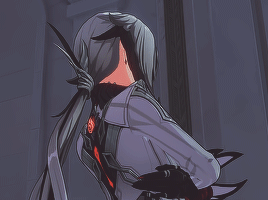

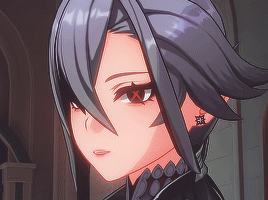


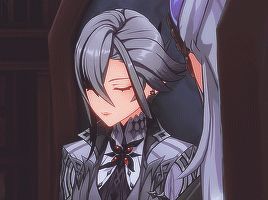
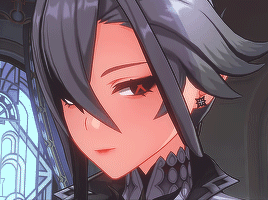
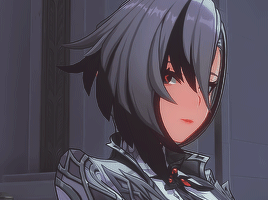
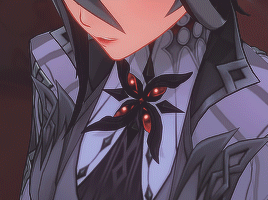
ARLECCHINO ❖ THE KNAVE
Do I look like an irresponsible Father to you? Hehe, the House of the Hearth is very important to me. You should know that I care deeply about my children.
3K notes
·
View notes
Text

原神3周年おめでとうございます
10 notes
·
View notes
Text
Riptide🌊
Vocals: Aruvn
Lyrics: Jonny Dyas & Yifei Tang
Music & Mix: Cloud Road Music
Director/Storyboard/Main Animator/Composite: RIRI YAMASHITA
Animator: tori Reon Nismogo 百藤
Producer: Koichi Kawase/Xenotoon Inc.
Premiere in 10 hours▶️youtu.be/g3zqwCiAg5c
#Taru fans are blessed#Kaveh's piece is my most favourite this year but this is second favourite hands down#Tartaglia#Genshin Impact#Fave#Riptide
50 notes
·
View notes
Text

"Guilty?"
"You call this justice? Your so-called 'Justice' is a joke!"
I'm surprised this is my first Delusion Tartaglia fanart... 😅
2023-09-02
937 notes
·
View notes
Text
Looking into Heart of Depth artifact descriptions again, and yeah, ok, it's about killing a whale/sea monster too.
Also:
When he was younger, Parsifal was known for his disobedience and love of chivalric play-acting which he developed from reading the tales and songs of his ancestors.
What is it with the theatre kids.
Also:
"Some five hundred years after their deaths, Parsifal and the Blue-Eyed Spear Witch were used as the basis for a play written by the Fontainian playwright Coppelius. This play inspired the stage names for the magician Parsifal the Great and her sister-and-assistant, Josephine."
Uhm... That magician knew Rene and Jakob. Lyney also uses his weapon ("The First Great Magic").
Why are they all connected in such a weird way. Not any actual meaningful connection, but... you know.
Also this set has a compass istead of a timepiece. In some stories the time doesn't matter, only the place?
27 notes
·
View notes
Text

4.0
1K notes
·
View notes
Text
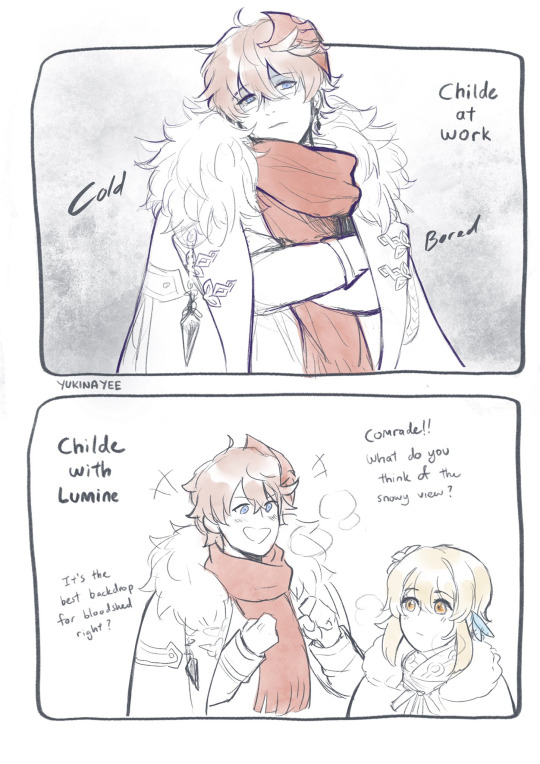

The duallity
3K notes
·
View notes
Text
ONE WEEK LEFT FOR 4.1!!!
youtube
I know trailers in Genshin have had a tendency to apply misdirection, but I'm SO vibing with how good this one has turned out! Is it just me or Genshin Impact in entering a Prison Break arc after the whole Ace Attorney sessions?
According to the livestream Traveler is somehow infiltrating the Fortress of Meropide prison to check on Tartaglia in particular? Maybe in the context of a case too, but wth, this is the kind of stuff I only find in my most favourite Chilumi fics! lol It almost feels like Hoyoverse has decided to take pity on my delusional heart and just give me a quality bread crumb for once. I feel like I've picked the absolute best time to finally C6 Childe alright; I LOVE FONTAINE'S ARCHON QUEST SO FAR!
Anyway,I know we've just started the new chapter, but I'm still excited because not many characters in Genshin have had this kind of treatment so far. Scaramouche in Sumeru comes to mind. But if they keep focusing on Tartaglia in Fontaine, they may be setting up a trend for when Traveler finally reaches Snezhnaya and they need the help of all bona-fide Harbingers they have assisted throughout the story (I'm not holding my breathe, but it would be nice to see something like that.).
I also love Lyney and Lynette to death. In the beginning I wasn't even all that excited for Fontaine, but them being affiliated to the Fatui has immediately sold the sibblings to me. The Harbingers remain the one thing that has keep me excited about Genshin, so much I have come to root for the rerunning theory that there's a faction inside that may be actually 'good', while some others are confirmed to be completely corrupted (being by power, hatred, money, or whatever) in spite whatever previous good nature they may have had in the past (RIP Signora).
My biggest surprise yet is that Lyney seems to be appointed to be Arlecchino's successor. This. This right here is what makes me suspect there's merit to that theory! If not in absolute terms at least in a relative terms. Idk, I just think it would be fun to see the Traveler's perception of their enemy change in more ways that one.
One more week!!! We may not even get that much information about Childe yet, but I'm so looking forward to it. xD
2 notes
·
View notes
Text
As a reminder, I report and block default-icon accounts as bots because I cannot tell the difference at a glance, and I will not waste my time investigating.
5K notes
·
View notes
Text

Daily reminder he is a clown in her dreams (this is official from a honkai collab)
126 notes
·
View notes
Text

監獄でも達者でなー!
193 notes
·
View notes
Text


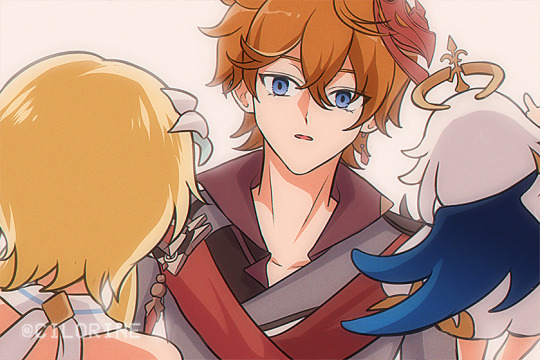
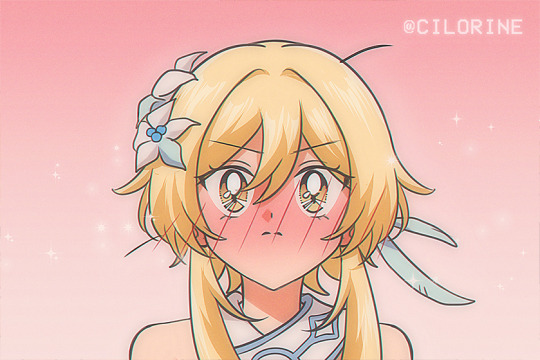
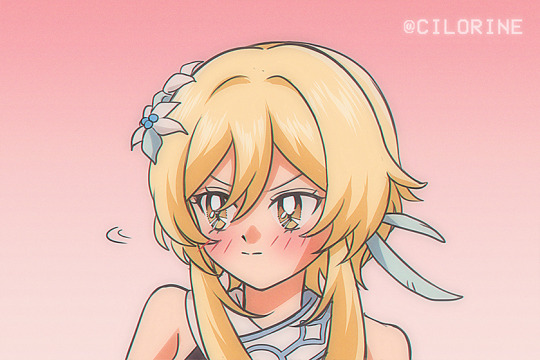
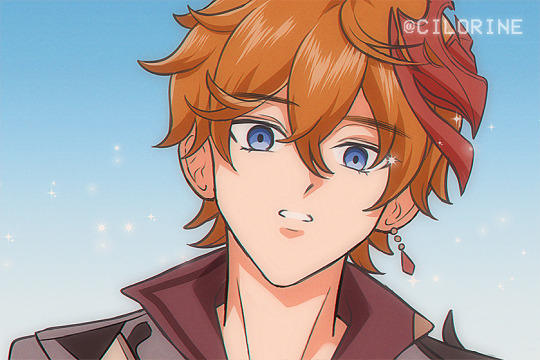


how that chilumi vision giving scene in fontaine goes in my head: the shoujo anime 💘
3K notes
·
View notes
